Distinguishing Features: Identification of Yellow-crested Cockatoos

Sulphur-crested Cockatoo on a lawn in a suburb of Sydney, Australia. © Kent Warner
White cockatoos with yellow crests are native to Australia, Tasmania, New Guinea, New Britain, Sulawesi, the Lesser Sundas, and many smaller adjacent islands. They are known generically to many English-speakers by the name Sulphur-crested Cockatoo, but technically this name refers only to one species within a larger group. Depending on which taxonomic references are consulted, the various populations represent anywhere from nine to fifteen subspecies, which have traditionally been regarded as comprising three species: Sulphur-crested (galerita plus three to five more) of Australia, Tasmania, and New Guinea; Yellow-crested (sulphurea plus three to seven more) of Sulawesi and the Lesser Sundas; and Blue-eyed (ophthalmica) of New Britain.
The traditional classification scheme is unsettled, however, as the Sulphur-crested and Yellow-crested subspecies groups each includes at least one recognizably distinct form that might be more appropriately reclassified as a separate species. In 2021 the Handbook of the Birds of the World and BirdLife International recognized the “Citron-crested Cockatoo” (citrinocristata) of Sumba Island as a species separate from Yellow-crested—though it is not yet certain that other authorities will adopt this change. Meanwhile the New Guinean populations of Sulphur-crested apparently differ from the Australian populations in size, orbital skin color, and ecology. Aviculturists refer to the New Guinean populations as the “Triton Cockatoo” (triton, and presumably also including the nearby eleonora), which might be more appropriately regarded as a separate species. The net result is at least five distinguishable species or forms of yellow-crested cockatoos.
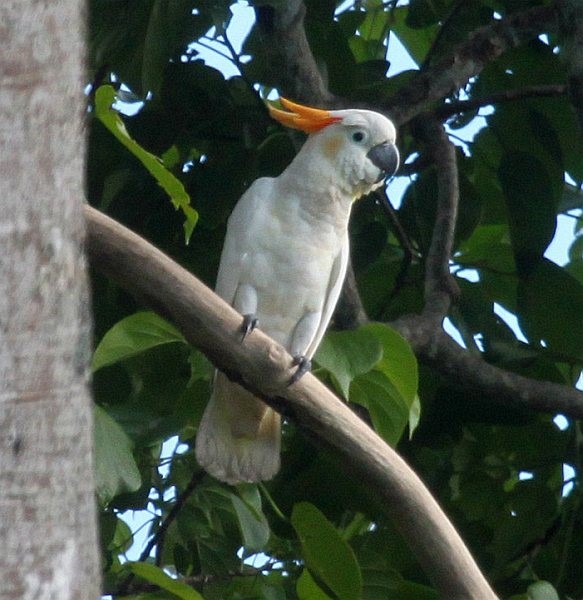
Starting in 2021, some taxonomic authorities have recognized the “Citron-crested Cockatoo”, C. s. citrinocristata, as a separate species. (Manurara, Manupeu Tanadaru National Park, Sumba, Indonesia; January 26, 2013.) © Hanom Bashari
Identification of the yellow-crested cockatoos should be as simple as knowing which island you’re standing on. Their natural ranges do not overlap and no landmass has more than one native form. As with other cockatoos, however, people seem powerless to resist their charms and have trapped hundreds of thousands, perhaps millions, of them to live as pets. Captive individuals have been transported worldwide and many have escaped or been released within one another’s natural ranges or in more distant locations—such as Hong Kong, Singapore, and Taiwan, where multi-species flocks of cockatoos have persisted ferally since the early or mid-1900s, resulting in introduced breeding populations with some amount of hybridization. Smaller feral flocks have occurred around other cities, including Honolulu, Manila, and Nassau (Bahamas), and released individuals can appear nearly anywhere.
The resulting identification challenges may have some consequences for conservation, as the feral populations become potentially useful as insurance against extinction. The clearest case of this benefit is the Hong Kong population of Yellow-crested Cockatoos, which (as of the early 2020s) appears likely to outlast the native populations of Indonesia and Timor-Leste.
In all areas, including their natural ranges, the identification of yellow-crested cockatoos can be complicated by the potential for multiple species or forms to exist ferally. Among the five species or distinct forms of yellow-crested white cockatoos listed above, two (Blue-eyed and “Citron-crested”) are relatively easy to identify, whereas the other three blend together.
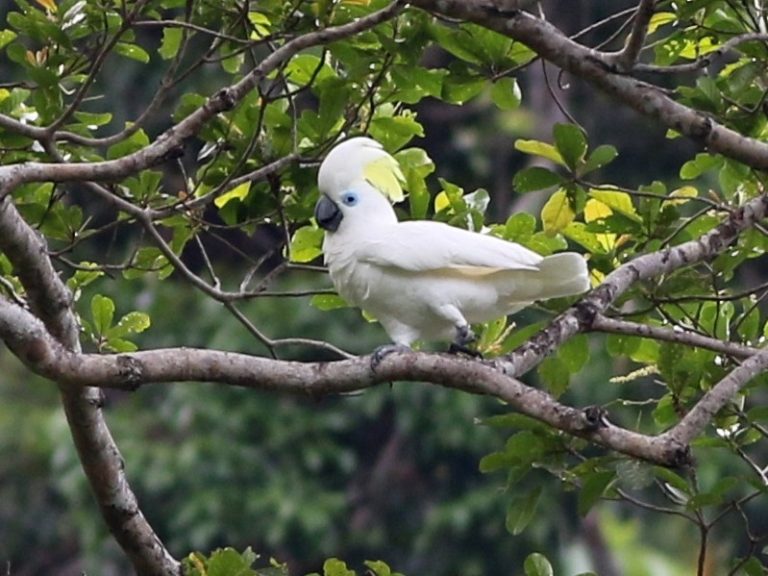
Unlike other yellow-crested cockatoo species, the Blue-eyed Cockatoo’s crest curls down and back. (Walindi Plantation, New Britain; August 31, 2019.) © Chris Wiley
Blue-eyed Cockatoo. Blue-eyed differs fundamentally from the others in the shape of its crest. All five forms have yellow-and-white crests that consist of a white “shield” at the front with several yellow feathers behind. On four forms the yellow feathers curl up and forward, whereas on Blue-eyed the yellow feathers curl down and backward. Blue-eyed’s crest also tends to be a paler shade of yellow than the others, but the shades vary somewhat in all three species. Blue-eyed is named for its characteristic orbital skin coloration, but this distinction is only partly reliable for identification because the “Triton Cockatoo” typically has bluish orbital skin (and northern Australian populations of Sulphur-crested reportedly sometimes show this as well).
There are no known introduced populations of Blue-eyed, so it remains mostly isolated within its native range on New Britain. However, small numbers are kept in captivity elsewhere, and apparent escapees have been reported from other islands in the Bismarck Archipelago (mainly on New Ireland).
“Citron-crested Cockatoo”. “Citron-crested” differs fundamentally from the others in the color of its crest, which is pale apricot-orange instead of yellow. This coloration usually appears distinctive in photographs, and would generally be reliable for the identification if a feral individual were encountered away from its native island, Sumba. However, the crest coloration of the other forms is variable enough to cause confusion in some cases, especially where hybrids may occur.
There are no known introduced populations of “Citron-crested”, but one or more individuals may have appeared around Singapore. Some of these individuals may be hybrids between Yellow-crested and other species such as Salmon-crested Cockatoo and Tanimbar Corella—as a result of hybridization that might occur either among feral birds or in aviaries. A possible indication that some may be hybrids is that they lack the orangish cheek patches that are typical of “Citron-crested”.
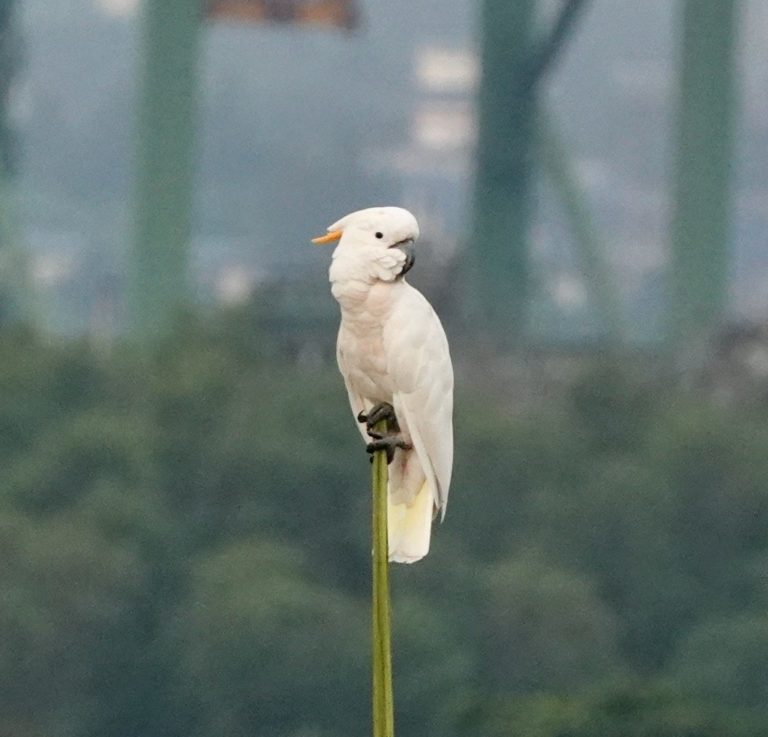
An apparent free-flying feral “Citron-crested Cockatoo” in Singapore. (September 2020.) © Marcel Finlay
According to a 2014 study (Collar and Marsden) of the subspecies traditionally classified as Yellow-crested, “Citron-crested” has comparatively long wings, tail, and crest feathers. However, an isolated Yellow-crested subspecies, abbotti, exceeds it in all of these measurements. Based on publicly available recordings, it appears that “Citron-crested” may have a deeper, mellower voice than other Yellow-crested.
Sulphur-crested Cockatoo. Australian populations of Sulphur-crested Cockatoo differ most notably from the other forms in being larger-bodied, larger-winged, and more adapted to diverse habitats—e.g., less arboreal, more inclined to open or semiopen habitats, including fields and lawns, and not exclusively tropical.
Sulphur-crested averages about 35% larger overall than Yellow-crested, and its body typically appears much lankier, less compact, whereas its bill usually appears proportionately smaller. The general impression of bill size relative to body length can be a good indicator, but it varies widely within both Sulphur-crested and Yellow-crested.
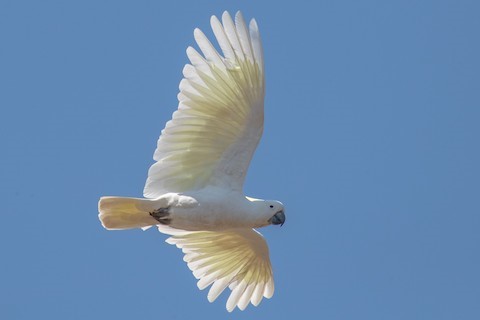
Sulphur-crested Cockatoo in flight, showing its proportionately long body and large wings. (Woodlands Historic Park, Greenvale, Victoria, Australia; November 13, 2017.) © Brendan Klick
Comparison of recorded measurements gives a clearer indication. The lengths of their bills overlap (Yellow-crested, 29-39 mm; Sulphur-crested, 34-50 mm), whereas their wing lengths are separated by a sizeable gap (Yellow-crested, 211-245 mm; Sulphur-crested, 295-391 mm). The recorded difference in tail feather length is even more striking, as the shortest Sulphur-crested (200-236 mm) is nearly double the longest Yellow-crested (98-115 mm).
Sulphur-crested has been widely introduced and apparently viable populations are established in New Zealand (both North and South Islands), with potentially viable ones in Hong Kong, Singapore, and Taiwan.
Yellow-crested Cockatoo. The Yellow-crested Cockatoo comprises somewhere between three and six subspecies (not including “Citron-crested”), each with fragmentary, depleted populations that inhabit isolated islands in eastern Indonesia and adjacent Timor-Leste. There is some variation within and among the natural populations—in particular, bill size seems to vary significantly. IUCN classifies it as critically endangered, following a precipitous decline from having been a common, widespread species in the mid-1900s.
In most cases, Yellow-crested is most likely to be confused with Sulphur-crested. For purposes of field identification, their plumages are essentially identical. Yellow-crested tends to show more yellow on its cheeks, but this is not a reliable distinction as Sulphur-crested also shows some yellow on the cheeks.
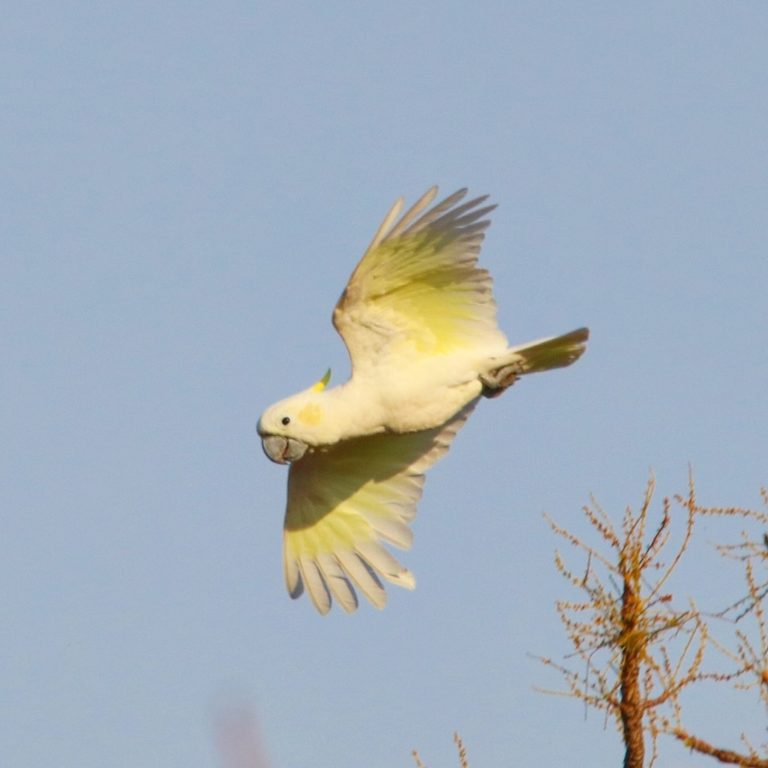
Yellow-crested Cockatoo, in flight, showing yellow cheek patch and wash on the undersides of wings. (Komodo Island, Nusa Tenggara, Indonesia; September 2018.) © Tim Avery
As discussed above, the size difference averages about 35% overall, and is most pronounced in the lengths of the body, wings, and tail. Yellow-crested generally gives the impression of a middle-sized parrot with a proportionately large bill, somewhat large head, and smallish body, whereas Sulphur-crested generally gives the impression of a large parrot with a large, lanky body and long wings.
“Triton Cockatoo”. The New Guinean populations classified under the Sulphur-crested Cockatoo are intermediate among the three currently recognized species: somewhat larger than Yellow-crested but smaller than typical Sulphur-crested, and like Blue-eyed they tend to have bluish orbital skin. Unlike typical Sulphur-crested, “Triton” seems to be exclusively a forest bird.
If encountered out of range—i.e., in a feral condition—“Triton” would be readily confused with both Yellow-crested and typical Sulphur-crested. The bill and head often appear proportionately large, which would tend to suggest Yellow-crested, but in overall size “Triton” is closer to typical Sulphur-crested. For example, the recorded wing measurements of “Triton” (261-347 mm) overlap extensively with those of typical Sulphur-crested (295-391 mm), but not at all with Yellow-crested (211-245 cm).
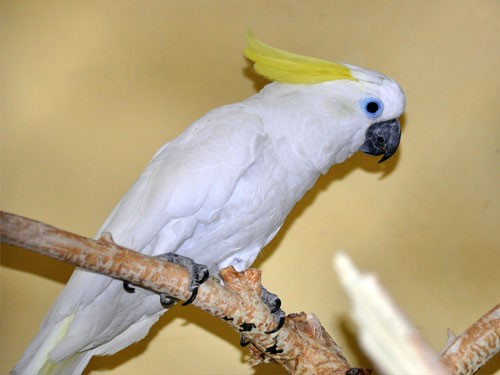
“Triton Cockatoo”, C. g. triton, close-up view of a captive individual, showing vivid powder-blue orbital skin. (Grodno Zoo.) © Zoo Institutes
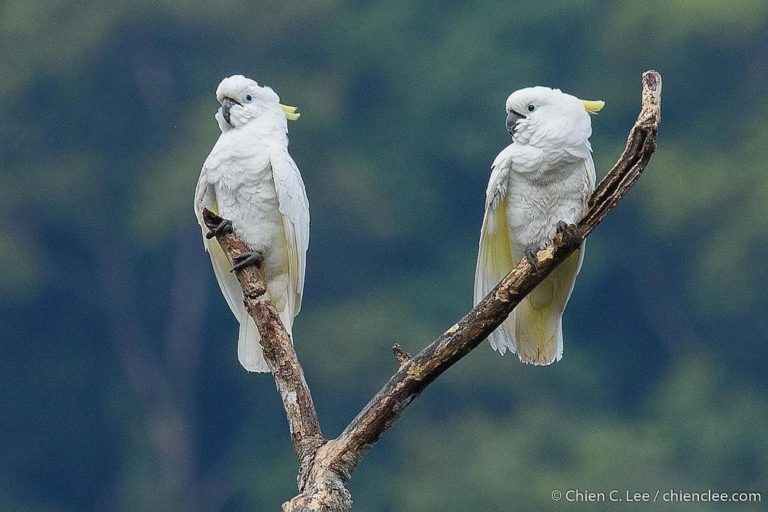
“Triton Cockatoo”, C. g. triton, pair, showing that bluish orbital skin is not a conspicuous field mark, and often unreliable for field identification. (Manokwari, West Papua, Indonesia; August 14, 2015.) © Chien C. Lee
“Triton’s” orbital skin coloration varies from white to powder-blue and the bluish tone is often undetectable under field conditions, so the absence (or apparent absence) of bluish tones does not rule out “Triton”. On the other hand, some Australian Sulphur-crested populations reportedly also show bluish orbital skin, at least occasionally, to some extent, so the presence of bluish tones does not necessarily confirm “Triton”. Even with those caveats, however, bluish orbital skin would still seem to be the most useful feature for differentiating “Triton” from both Yellow-crested and typical Sulphur-crested.
The “Triton Cockatoo” is widely kept in captivity but apparently has not been detected in any of the mixed-species populations of feral cockatoos. A well-established population of Sulphur-crested Cockatoos in Palau has been ascribed to triton (but with the caveat that this identification does not appear to be independently verifiable from publicly available materials).
References
BirdLife International. 2018. Cacatua galerita. The IUCN Red List of Threatened Species 2018: e.T22684781A131914971. https://dx.doi.org/10.2305/IUCN.UK.2018-2.RLTS.T22684781A131914971.en. (Accessed August 25, 2021.)
BirdLife International. 2018. Cacatua ophthalmica. The IUCN Red List of Threatened Species 2018: e.T22728429A132032417. https://dx.doi.org/10.2305/IUCN.UK.2018-2.RLTS.T22728429A132032417.en. (Accessed August 5, 2021.)
BirdLife International. 2018. Cacatua sulphurea. The IUCN Red List of Threatened Species 2018: e.T22684777A131874695. https://dx.doi.org/10.2305/IUCN.UK.2018-2.RLTS.T22684777A131874695.en. (Accessed August 27, 2021.)
BirdLife International. 2021. BirdLife’s Globally Threatened Bird Forums: Citron-crested Cockatoo (Cacatua citrinocristata): Revise global status? https://globally-threatened-bird-forums.birdlife.org/citron-crested-cockatoo-cacatua-citrinocristata-revise-global-status/. (Posted June 2, 2021. Accessed August 10, 2021.)
BirdLife International. 2021. BirdLife’s Globally Threatened Bird Forums: Citron-crested Cockatoo (Cacatua citrinocristata): Revise global status? https://globally-threatened-bird-forums.birdlife.org/citron-crested-cockatoo-cacatua-citrinocristata-revise-global-status/. (Posted June 2, 2021. Accessed August 10, 2021.)
Cameron, M. 2007. Cockatoos. CSIRO Publishing, Collingwood, Victoria, Australia.
Collar, N.J., and S.J. Marsden. 2014. The subspecies of Yellow-crested Cockatoo Cacatua sulphurea. Forktail 30:23-27.
eBird. 2021. eBird: An online database of bird distribution and abundance. Cornell Lab of Ornithology, Ithaca, N.Y. http://www.ebird.org. (Accessed August 31, 2021.)
Forshaw, J.M. 2010. Parrots of the World. Princeton University Press.
Juniper, T., and M. Parr. 1998. Parrots: A Guide to Parrots of the World. Yale University Press.
Kirwan, G.M., A. Levesque, M. Oberle, and C.J. Sharpe. 2019. Birds of the West Indies. Lynx Edicions, Barcelona.
Lin, R.S. and P.F. Lee. 2006. Status of Feral Populations of Exotic Cockatoos (Genus Cacatua) in Taiwan. Tawania 51:188-194.
Michigan State University. 2021. AVoCet: Avian Vocalizations Center. https://avocet.integrativebiology.natsci.msu.edu/. (Accessed August 31, 2021.)
Mulawki, E.J. 2014. The Cockatoos: A Complete Guide to the 21 Species. McFarland Publishing, Jefferson, N.C.
Pyle, R.L., and P. Pyle. 2017. The Birds of the Hawaiian Islands: Occurrence, History, Distribution, and Status. Version 2 (January 1, 2017). http://hbs.bishopmuseum.org/birds/rlp-monograph/. B.P. Bishop Museum, Honolulu, Hawaii.
Xeno-Canto. 2021. Sulphur-crested Cockatoo – Cacatua galerita. https://www.xeno-canto.org/species/Cacatua-galerita. (Accessed August 31, 2021.)
Text © Russell Fraker / September 1, 2021